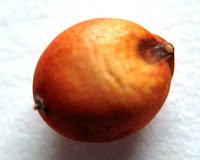As many of the early sorghum crops reach physiological maturity, and approach harvest, questions are being asked as to whether it is necessary to control large populations of nymphs in these crops. More specifically, whether these RGB will cause any damage to the maturing grain between physiological maturity and harvest.
Photo: Dave Murray (BigBug) out looking at a sorghum crop at Glen Ogden’s property on the Darling Downs.
In summary, the best available information suggests that sorghum is will not suffer yield loss as a result of RGB feeding from physiological maturity (hard dough) through to harvest.
DPI&F trials to examine the impact of RGB on grain as it matured, did not provide a conclusive answer to this question. In 2008 we are undertaking field trials to try and answer this question.
However, if we look at what is happening with the sorghum plant from physiological maturity on, we can draw some conclusions about the potential for RGB to cause damage to maturing grain. Importantly, once grain reaches physiological maturity it has reached its full potential weight, and from then on starts to lose moisture as it matures. This means that even if large numbers of RGB continue to feed on the sorghum plant (on stems and leaves) their feeding will not impact on the development of filling of the grain at this stage.
Photo (left): Physiological maturity is reached when a black layer appears at the base of the seed, near to where the seed is attached to the stem
Another question that we do not have a definative answer to is whether RGB continue to feed directly on the maturing seed, or if they feed only on the sorghum plant once the grain reaches hard dough. In trials where plants at hard dough were exposed to RGB we did not see the evidence of feeding damage to grain that we saw when heads were infested at earlier stages of grain development (see earlier posting on RGB damage).
Crops that have had early infestations of RGB, even some of those that have been treated, now have moderate to large populations of nymphs and adults in them. The adults are likely to be newly emerged, having developed from nymphs in the crop. The nymphs will have emerged from eggs that were laid by an earlier infestation.
Controlling RGB to prevent the problems associated with infestations at harvest remains an issue. The inclusion of an insecticide along with the herbicide when the crop is being sprayed out prior to harvest is a practical approach. Be alert to the witholding period of any insecticide used. Treatment with insecticide prior to harvest is not a guarantee that the crop will be free of RGB at harvest. There remains the possibility of reinvasion by adults at any time.


